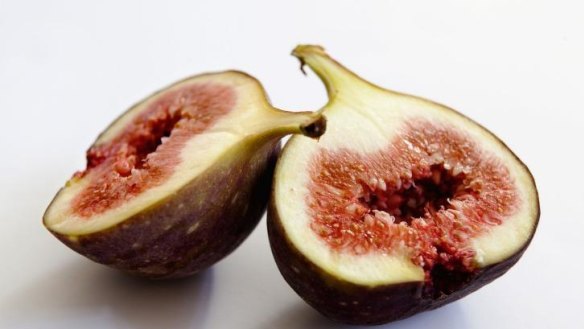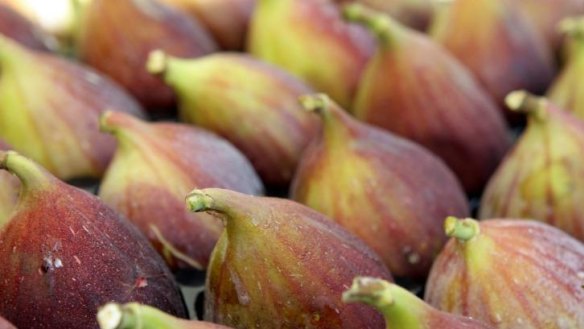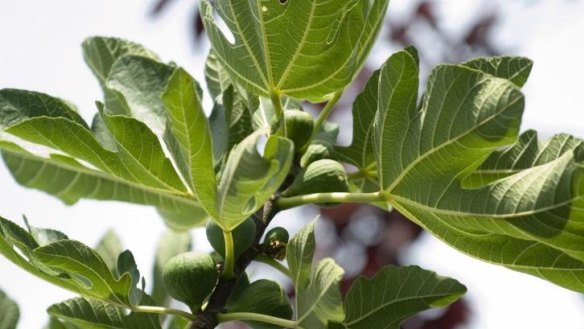Canberra's autumn fig harvest bears fruit

The big green leaves of the fig trees are partially sheltering the ripening figs from the hot afternoon sun. Thank goodness the fig harvest has arrived again in earnest, and that our Canberra gardens produce fine specimens of this wonderful royal fruit.
A fig picked fresh from the tree, ripened by the sun, is one of the most beautiful fruits to be found in the hot lands of the Mediterranean as well as the inland areas of Australia. The ancient Egyptians rightly called it "the tree of life".
Figs are so versatile in that they can be roasted, poached or stewed, sliced and added to salads, used in baking or simply halved to serve in a dish of delicacies. If you have an excess, they can also be dried, preserved or turned into delicious fig jam. Top class restaurants are seeking out local supplies to add to their dessert menus. Restaurants such as Temporada will lightly grill many of their supplies, to serve with a range of dishes. Aubergine, in Griffith, and Temporada, in Moore Street, have also perfected an exquisite fig leaf ice-cream.

We have had a pretty dry summer which fig trees do enjoy, but the crop does need supplementary watering. . The secret to good fig production is to grow your trees in a rich, free-draining soil with neutral pH. Every year in the springtime, spread a generous quantity of good compost around the tree and provide some mulch to keep the moisture content up.
The harvest period continues for several weeks. Figs are easy to harvest and should be picked when they have turned in colour and are slightly soft to touch. Handle with care for they are truly a soft fruit and bruise easily. They will have a sweet smell at this point and can be eaten fresh from the tree. Figs do not continue to ripen once harvested.
Brown turkey is one of the earliest varieties to ripen during the main autumn harvest and will continue to bear for a long period. It is a medium-sized fig with light green skin turning a shade of brown. The flesh is pinkish brown with excellent sweetness.

Brown turkey is a hardy variety, doing well in inland regions. It has quite sparse foliage, unlike most other varieties with their big shady canopies. It is, however, a reliable cropper and does cope well with difficult growing conditions.
There are a number of other light-coloured fig varieties now available. White genoa is one of the best all-round fig varieties. It produces large, pear-shaped figs with a light yellow-greenish skin. The fruit has a mild taste and is reddish pink in colour. Yellow excel is a popular variety in parts of NSW. The figs are light yellow in colour, with amber flesh. They have a mild flavour and are delicious fresh.
Another fine whitish fig is white adriatic. Its flesh is a real contrast and is sometimes called the "strawberry jam" fig. Its red flesh has the sweetness of ripe strawberries, both in flavour and quality.
![Fig and rocket salad. From: Georgie Graham [mailto:GeorgieGraham@hardiegrant.com.au] Sent: Wednesday, 9 December 2009 3:36 PM To: Lissa Christopher Subject: FW: Image 2 of 3 for In the Kitchen ______________________________________________________________________ This email has been scanned by the MessageLabs Email Security System. For more information please visit http://www.messagelabs.com/email ______________________________________________________________________](https://static.ffx.io/images/w_584%2Ch_876%2Cc_fill%2Cg_auto:faces/q_86%2Cf_auto/e5e4e8ef0c20a4f4ec0fc75235509e0d69a09b3f)
Black genoa is probably the most well-known of the dark-coloured figs. Its canopy of leaves is grand and the large fruit are very sweet and rich in taste. It is also a very reliable cropper, producing both an early crop before Christmas and a main autumn crop.
The "preston prolific" is a chance seedling of the black genoa with a fineness of its own. It had its origins in an orchard in Victoria. The skin of the fruit is purplish brown when fully ripe but the flesh is creamy white in colour and very thick. It is quite a juicy fig with a distinctive, sweet flavour.
Silvan beauty is another fine Victorian fig, first discovered in the Dandenong Ranges. It is purple skinned with an amber coloured flesh. The flavour is really good and the tree is heavy bearing.
Our 30-year-old black genoa tree is carrying a crop of 300-plus figs and our large brown turkey tree is already producing a lot of ripe fruit. Shoppers at the Saturday Capital Region Farmers Market seek out tray packs of organic figs as energetically as they do the chemical-free strawberries. Loriendale orchard is also excited about the first fruitings of 20-plus small fig trees, which include most of the varieties mentioned above. These little trees were planted in the past four years and given lots of supplementary waterings to get them well established.
Fig and Rocket Salad
100g bacon
2 cloves garlic
2 tbsp olive oil
8 medium figs, quartered
200g baby rocket leaves
50g mizuna leaves
3 tbsp toasted pine nuts
¼ cup Parmesan cheese, grated
Balsamic vinegar
Dice the bacon and finely chop the garlic. Heat the olive oil in a frying pan and cook the bacon pieces until well browned. Finely chop the garlic and add to the bacon; stir in well, then add in the figs and cook for about two minutes but remove from heat before the figs fall apart. Allow to cool.
Mix the rocket leaves with the mizuna, pine nuts and parmesan cheese. Plate up the salad and top with the bacon-fig mixture. Drizzle with balsamic vinegar and serve.
This week in the garden
Plant a row of open-leaf lettuces, rocket and radish for a mid-autumn harvest.
Plant kale, leeks and kohlrabi as longer-term crops.
Clean off summer garden beds and add compost to plant out wintertime brassica seedlings and a bed of shelling peas and snow peas.
When harvesting mature pumpkins, keep their stems intact and place them in a reasonably sunny location so that their skins will harden and seal well, so that they will store well.
Dig up potatoes where the stems have dried up. Store your crop in a dry, cool location out of direct sunlight.
Turn over your summer compost heaps and clear a space to start a new heap for all of the autumn plant materials being removed from the garden. Always add in layers of old animal manures and some freshly cut green grass to generate heat. Keep all old tomato plants out of the compost.
Owen Pidgeon runs the Loriendale Organic Orchard near Hall.
The best recipes from Australia's leading chefs straight to your inbox.
Sign up